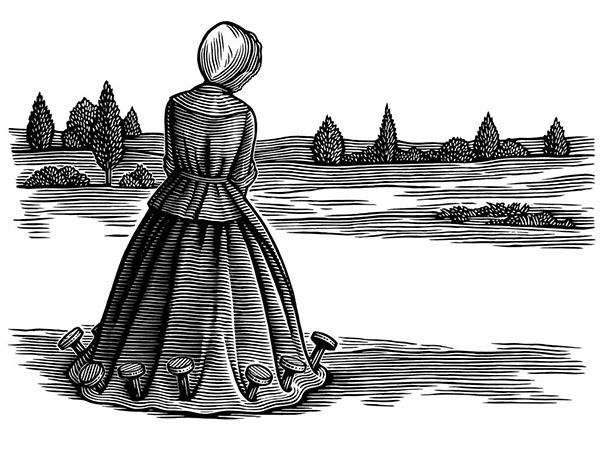
The letters of an obscure New England woman, who happened to have a famous brother, offers a glimpse at a life of sorrow and bad luck in colonial America.
Benjamin Franklin had sixteen siblings. The youngest was Jane, whom he called “ever my peculiar favorite.” He was six when she was born in 1712 and he ran away from their home in Boston when she was eleven.
Franklin Successful as Printer; Famous as Writer, Scientist, Diplomat
Luck seemed to follow Benjamin. He became successful as a printer and enormously famous as a writer, scientist, and diplomat. Her life was more mundane and far less lucky. She was married at fifteen to Edward Mecom, a man six years older. She eventually had twelve children, but three died in infancy and most of the surviving children struggled with illness—physical and mental—and failure. Edward was also sickly, suffering apparently from tuberculosis.Through it all, she struggled to fight depression and stay out of poverty.
In the 1760s, the Mecoms had a house on Boston’s Hanover Street. In the front room of the house was Edward’s shop. He made and repaired saddles and harnesses, although by this time Edward was too sick to do much work. What work was being done in the shop was by a son, Josiah. From this shop, the family also sold miscellaneous products, including spices, soap, butter, raisins, mustard seed, tobacco, needles, and rum.
The room behind the shop was a dining room with a small fireplace. This room was furnished with a desk, looking glass, table, nine chairs, and some pictures. The family silver comprised three large spoons, nine teaspoons, and tea tongs.
Pewter Dishes, Brass and Iron Candlesticks, Warming Pan
Behind the dining room was the kitchen with a somewhat larger fireplace. In the kitchen, were pewter dishes, various cooking utensils, nine brass and iron candlesticks, and a warming pan.
Upstairs and beyond—in the garret—were the bedrooms—it’s uncertain how many—five bedsteads, feather beds, straw beds, a servant’s bed and bedding, a couch, seven chairs, two chests, a “case” of drawers, and a looking glass.
Boarding House Respectable Enough for Out-Of-Town Lawmakers
These beds accommodated not just the family, but boarders as well. The saddle shop couldn’t support the growing family, so after the birth of the seventh child, the family began to take in boarders. The Mecom boarding house was respectable enough for some lawmakers from out of town attending sessions of the provincial assembly. The house took in as many as six boarders at a time.
In 1762, six people were living under one roof: Jane, Edward, Josiah, two sickly daughters of Jane and Edward, and a lodger, the stepdaughter of one of Jane’s late sisters (by this time Jane and Benjamin were two of just three surviving siblings.)
It was in this household that Jane played host Benjamin and Benjamin’s daughter for several months in 1762. Benjamin stayed longer than expected to recover from a dislocated shoulder.
Fabrics and Patterns from London, But Bad Time to Start Business
By 1766, Benjamin was in London and Jane, still in Boston, was a widow desperately trying to make ends meet. She had made arrangements for Benjamin’s London landlady to send her fabrics and paper patterns of London fashions. Jane hoped to sell these in Boston. Jane’s goods arrived in May. By November advertisements were appearing in Boston newspapers: “to be sold by Jane Mecom at her house. . .a few articles of Millinary. . .all new from London” and “made from the newest Fashion Patterns with Care and Expedition.”
However, this was about the worse possible time to embark on a business in America selling British imports. A move was afoot among Americans to boycott British-made goods and to cut back on spending for luxuries. Americans were saving money and also protesting taxes being imposed by the British Parliament. By December, it was clear that Jane’s venture was faltering. She wrote her brother: “It proves a Litle unlucky for me that our People have taken it in their heads to be so Excesive Frugal at this Time as you will see by the news papers.”
Sadness Over Death of Loved Ones, Especially Nineteen-Year-Old Daughter
Amid all this, Jane was battling crushing sadness over her deaths of loved ones, especially the death over the summer of nineteen-year-old daughter Polly. Writing to thank Benjamin for the money he sent for her business, Jane said: “I am not unsenceabl of the obligation you contineualy Lay me under but Realy my Spirits are so much Broken with this Last Hevy Stroke of Provedenc that I am not capable of Expressing my self as I ought. Oh My Brother she was Every thing to me.”
After the battles of Lexington and Concord, Jane fled Boston, first to Rhode Island, then to Philadelphia. After the Redcoats left Boston, Jane learned that her Boston home had been looted. She stayed in Philadelphia. The war, however, forced her to flee to Goshen, Pennsylvania, and then to Rhode Island. She spent some of 1778 making “ruffled shirts and stockings” for the American soldiers.
Meanwhile, death took more of her children. By 1779, only one remained. She finally returned to Boston and lived in a house just behind Old North Church with her surviving daughter, the daughter’s husband, and a daughter of one of her deceased sons. In 1786, workmen replaced the great steeple on Old North. Jane, well acquainted with her brother’s inventions, was troubled: in her opinion, the steeple’s “Electricil wier was too small to conduct a Large Strook of Lightning.” She was later reassured that the thickness of the wire had been increased three-fold. She died in 1794, age eighty-two.







